


 |
 |
 |
|
|
||
| Cherokee
County Families
|
|---|
 |
Memories and Stories |  |
| Richard D. Cleaves From My Past: Cherokee, Iowa to New York City 1909 to 1933 |
| 1.
Dick’s Introductory Thoughts on Cherokee, Iowa Whenever I am asked “Where are you from originally?” and answer, “Cherokee, Iowa,” there is usually a knowing look and an “Oh, yes.” But I have yet to meet a person other than a fellow Iowan who had ever been there or had even heard of it. And that Iowan will add to “Oh, yes” with “That’s where you have the State Hospital for the Insane.” A look at the map will show why no out-of-state drivers on the East-West or the North-South route ever went through Cherokee. US 20 crossing Iowa from Dubuque to Sioux City misses Cherokee to the south by 34 miles. The nearest cross-state highway to the north is US 18, almost the same distance away. With apologies to St. Joseph, Missouri, and Worthington, Minnesota, US 59 through Cherokee goes from nowhere to nowhere. Nevertheless, Cherokee is a typical and interesting mid-America rural town that more people should know, both Americans and foreign visitors whose impressions of the United States are taken from New York, Washington, San Francisco and Los Angeles. It is in the heart of the corn belt with among the highest yields per acre of anywhere in the country. I remember as a boy that on a hot July day we could lie on our backs in a corn row and actually hear the corn growing. The local legend was that Cherokee Country over the years consistently had the highest corn yields. The reason was that, when there was a tornado or a hail storm in northwest Iowa, the damage never extended over the Cherokee county line. Cherokee Prospects - Early 20th Century
2. Halley’s Comet I can start with my earliest memories. One of them is that I was born in 1909 March. In 1910 -- as I remember -- that was a year of Halley's Comet. I have a recollection that my dad woke me and my brother Prent up one night. Young
Richard and Prent Cleaves
He had us look out the window to show us Halley’s Comet. My recollection is that I was not impressed at all since it just looked like a star with a trailing tail or small burn. Halley’s
Comet, between May 14 and 22, 1910
[Editor’s Note: Readers of this memoir will be impressed by Dick’s ability to recall details from many decades earlier. Dick’s memory of his reaction to Halley’s comet as a 14-month-old, however, probably came from his parents’ description in later years.] 3. Grandmother Delaplane Another early recollection was when my grandmother Delaplane died. She was my mother's mother and I don't know what year that was. But Prent and I were very small boys and they decided it was not a good idea to have these two small children see my grandmother in the guest room, laid out in a coffin awaiting the tomb. Of course, we were curious. When nobody was around, Prent and I went in and saw my grandmother. We sneaked in and out again. [Editor’s Note: Emma Louise Steinhart Delaplane was born 31 Jul 1842 in Pennsylvania. She died 28 Nov 1913 at Tipton, Iowa, when Dick was 4 years old. Grandma Emma had three children, the youngest being Jane (“Jennie”) Eleanor Delaplane Cleaves (Dick’s mother), born 28 Apr 1875 in Tipton, Iowa and died 12 Jan 1960, in San Diego, California (where Dick’s brother Prent was living). Emma Louise’s tombstone is in Masonic Cemetery, Tipton, Iowa. Dick’s mother Jane is buried in Cherokee, Iowa.] Emma
Delaplane’s
Tombstone
Prent and Dick in 1914
We used to go to Sunday school regularly every Sunday. We tell the story that we came home after Sunday school one day and they asked us what we learned or what we have done. We said we'd learned all about the cross-eyed bear. There's a song about it – They said, “What do you mean the cross-eyed bear?” So, we sang the song. “Find me the cross-eyed bear.” That was my recollection.  Dad was a doc, born in Cook County, Illinois. He graduated from the University of Michigan and his uncle Royal was practicing in Cherokee, so Dad took up a practice with him. At the beginning, Dad stayed with him until Royal died. Dad was an excellent surgeon. In those years, Doc Seaman had a cancer clinic, called Cancer Clinic in Cherokee. The Cancer Clinic was later was denounced by the American Medical Association because somebody would come to Doc Seaman, say with a bruised growth on his neck. Doc Seaman always said -- This is malignant and under my methods we're going to cure you and so forth. For all the difficult operations, Dad would do for him. He would get ahold of Dad and Dad would operate on this benign tumor. The guy would go back to his farm someplace in Iowa and he would write a glowing testimonial about how he'd been cured of cancer at the Seaman Clinic. Dr. Charles
Ora Seaman’s Cancer Infirmary
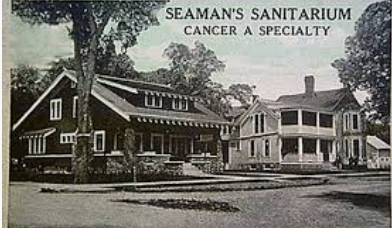 At the time Dad moved to Cherokee, there were three very eligible bachelors. One of them was Guy Gillette, who later became a congressman and senator and for whom I worked in Washington. And Dad… Guy was a lawyer and of course Dad was a doctor. Ralph McCullough was another bachelor... and they lived together and were just the most eligible bachelors that you could imagine. Then my mother came to be with her brother -- Galen Delaplane, who ran the shoe store in Cherokee. Mother came from Tipton where she's been living with her sister Mary France and her husband James France who was a lawyer. She attended Oberlin College in Ohio in 1893-4 and Cornell College in Mt. Vernon, Iowa in 1905 and taken piano in the Conservatory of Music. She came to Cherokee to continue piano lessons.
About this time Rose Freeman came to Cherokee as a teacher. Guy, I guess, had gone out with her a few times, and suddenly Guy Gillette said that he was going to marry Rose. This was a surprise that no one could understand since number one Rose was Jewish in a very prejudiced town at the time and number two, she was not nearly as attractive as a lot of the young girls in Cherokee. And it was done very suddenly. My mother I think was in love with Guy Gillette and I guess every other girl was too. My mother always felt that the Rose somehow had more or less blackmailed him into marrying her.
Mother married Dad. [Editor’s note: Dr. Prentiss Cleaves and Jane Delaplane were married 9 June 1906. Jane was 31 years old and Dr. Prentiss, born July 11, 1879, was a month shy of his 27th birthday.] She never liked her brother's wife, Mary Delaplane. My mother was a very strange woman. I think her problem came from the fact that she never felt she had financial security. My Dad was a very bad businessman. For 20 years after World War I he never sent a billing. He had an office in the Delaplane building owned by the three Delaplane girls -- Peg, Helen and the older sister Lelia. After he died, they told Prent and me that for the past seven years he never paid any rent. But they didn’t feel badly about it because any time they got sick, Dad did not charge them for treatment. More about my mother. She was a beautiful woman when she was young and even when she was older. Jane Emma
Delaplane Cleaves
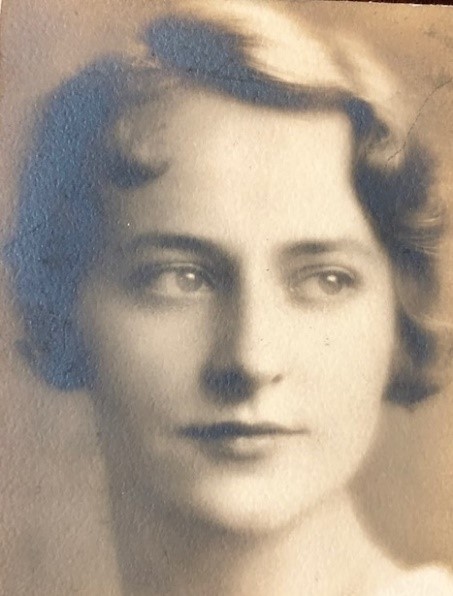 One
thing about my mother and father’s marriage was that Mother never had
any sense of security at all, and I think it affected her. She took it
out on Dad, she took it out on Prent and me.
She had prejudices against people. It started with the Delaplanes. They were our cousins and Mother could never stand them. Let's say some new people would come to town. Mother would invite the wife over and be so nice and they would get along fine. The new arrival would think that Mom was the greatest person in the world. Mother would say to this lady, “Have you met the Delaplanes?” They’d say, “Yes, I met them,” and Mother would say “Well, of course, you mustn't see them anymore.” And then Mother would tell what she felt of the Delaplanes. At that point, you either had to be on my mother's side or the Delaplanes’ side. There was no middle ground. If these people would have anything to do with the Delaplanes, my mother was all through with them. You were either a friend of my mother or an enemy. If you did anything with the Delaplanes, you were an enemy. She even carried the Delaplane thing to the point that when Margo and I were going to get married in Peoria and we're making out the guest list, Mother came to me and said “You’re not going to invite the Delaplanes.” And I said “Of course we’re inviting the Delaplanes. They’re my cousins.” Mother was very much upset about that. [Editor’s Note: We do not know the cause of Jane’s resentment, although it might have related to different levels of family finances between the Delaplanes and Cleaves. We chose to retain Dick’s comments because Jane’s attitude of a century ago was certainly known generally in the Cherokee community “where everyone knew almost everything about everybody,” and Jane’s views were likely part of local gossip.] 219 West Main Street, Cherokee, Iowa
[Editor’s Note: In 1909 Galen Delaplane owned this building. Daughters Helen, Lelia and Margaret ran the Delaplane Shoe Store on the ground floor. Dr. Cleaves had his offices on the upper floor.]
I remember we lived on Fountain Street before the roads were paved. Prent and I would go out in the middle of the street and it was a great place to play in the dust and the dirt. Then Mother would come running out after us, get us in the house and spank us hard. Dad decided to take us in hand. Dad got a taxi one day and told the taxi driver what to do. Prent and I were playing out in the street. The Model T taxi driver with Dad in the back seat came right up fast and just before hitting us stopped the taxi. We went screaming into the house and that was the last time we played in the dirt in the street. [Editor’s Note: The family address was 347 Fountain Street, as listed in the 1909 General Catalogue of Jane’s alma mater, Oberlin College. The Fountain Street home was built in 1900, had 3 bedrooms and 1.5 baths on 1600 sq. ft. The Delaplanes lived at 419 Euclid Avenue, a one-minute walk from the Cleaves home. The Cleaves later moved to a larger home at 730 West Main Street, pictured near the bottom of this memoir.] 347
Fountain Street (current photo)
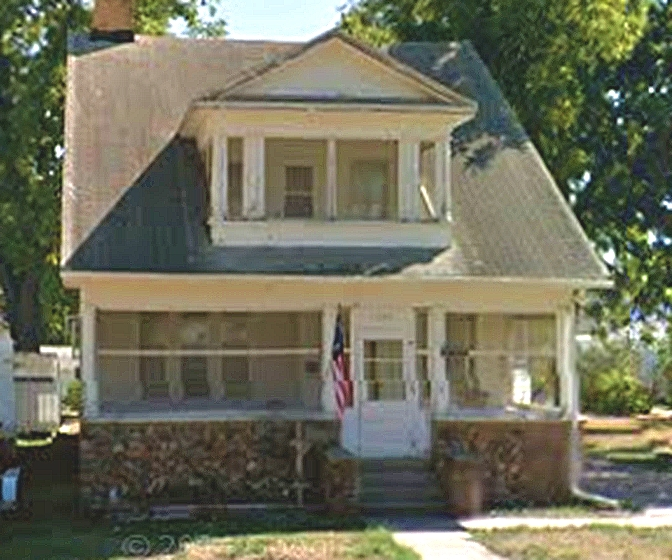  Home of
Galen, Margaret, Lelia and Helen Delaplane, 419 Euclid Avenue, Cherokee
 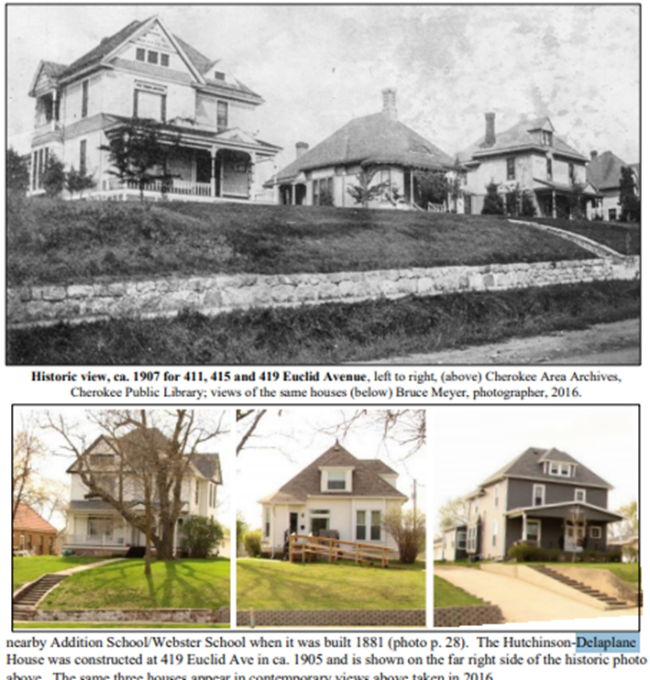 Once I did get hit by a car and it was my own fault. I was just a little boy and Dad was going out on a call in a cab. I thought it would be funny to run to the front of the cab. I was standing on the sidewalk and Dad got in the cab and I tried to run out in front of it. The cab driver didn't see me, hit me, knocked me over, and scraped my leg, my arms, and my face but I wasn't badly hurt at all. I suppose I was about three or four years old. That cured me from running in front of cars. Dad finally got a car -- Model T of course --- and I learned to drive. I was driving at 16 -- and there were no licenses then. I had the car one winter night. It stalled and I couldn't get it started and of course we had no antifreeze. Very stupidly I didn't do anything. I just left it on the street and of course the next morning it was frozen, and it had broken the head of the car which had to be replaced. In those days it was not inexpensive in terms of the times but was not a terribly expensive job because the Model T was quite simply put together. When I had my own Model T, I used to change spark plugs, change the points and work on the magneto and do all of those things myself because it was a very simple thing to do. Dad at later got a Studebaker coupe, of which he was very proud. You just figured it was the best-looking car in town. I was out with him one day (this is some years later), we were driving along, maybe East Main Street, and we turned down a street and he said, “You see that house way down there on the end. That's where so-and-so lives.” Main Street
in Old Cherokee
The fellow worked in the Ice House. In the winter they used to go out and cut the ice off the ponds and keep it in the Ice House covered with sawdust for the summer. Anyway, Dad was talking about the wife – “She’s Doc Weston’s patient. About twice a week she would say that she was really sick. Doc Weston would come down and park his buggy in front of the house, go in for an hour or so, and then he’d come out again. It got to the point that the horse knew the way so well that when Doc Weston started down East Main Street, the horse would pull over right in front of the house and stop.” Just at that point we were just about to pass the house and Dad's car stopped -- just died right there in front of the house. I started laughing. Dad was very embarrassed, and he didn’t take it very well. 7. Hooking Bobs Cherokee in those days was a wonderful place to grow up. I don't know which seasons we liked the best. I think maybe the winter season when the snows came because the streets were not plowed and there were very few automobiles. The farmers would take the wheels off their corn wagons and put on sled runners and would come into town with their sleds. We called them “bobs.”
Every Saturday was a big day in town. In the wintertime we would go out when these bobsleds and teams of horses would come by. We would jump on the runners and ride along for a ways and then we’d jump off and catch another one going the other way. Sometimes we would take our sleds, belly flop on the sleds and grab hold of the runners and be carried along that way. I remember one time we hooked a bob which was going west on Main Street and the young fella in the back of the bob, the wagon part, grabbed our hats and he wouldn't give them back. And so we rode that bob way up the top of Cemetery Hill, about a mile out of town, and he finally gave us our hats back. And of course, it was late in the afternoon and there were no bobs going into town, so we had to walk all the way back. 8. Skis We also used to go sledding at night in the bright moonlight, sometimes on a bobsled. We had ice skates and we’d go skating. Dad decided to make us skis. He went down to the lumber yard and got some tongue and grooved lumber. He took it to our basement, took off the male side of the ski and sharpened the point. He rigged up a steam box in such a way that he could put the end of the ski in the box and bend it. It would steam and then it would take the shape so that the front of your skis came up so you wouldn't snag on the slump. We tried to ski but we didn’t do very well because we didn’t have the proper bindings, just a strap across your feet. Of course, every time you turned, you’d come out of the skis and one ski would go down the hill and you’d have to go chasing after it. That was the winters.
9. Grocery Truck in the Early Spring Every couple of years in the spring, after the snows are gone when the spring had come, I’d come home and find we’d had an ice storm. It was beautiful to see the trees all covered with ice. The ice covered the streets and even the lawns. It was great because as long as the ice hadn’t melted yet, you could skate any place – you skate across people’s lawns, you could skate down the street, on the sidewalks, or anyplace. It just converted all of Cherokee into a big skating rink. When the snow would melt on a nice warm day, the gutters would run full. We would like to block or dam the gutters with the water in a pond behind. It was just fun to do. In those days, the groceries were delivered in a grocery truck, which was an open bedded truck with a roof over it. Grocery Truck
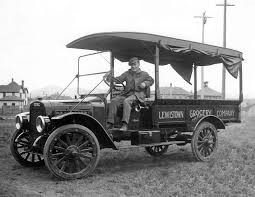 The
grocery orders were made up in the store and put in a basket and then
they would load the truck and make the deliveries. Once one
spring morning after we made our dam, this grocery truck came
along. These young fellers on the grocery truck thought it would
be a great idea to run through our dam. They turned the truck to next
to the curb and they ran through the dam and of course it spattered us
and broke our dam. We made the dam again, and again they came
through a little later and went right through our dam again.
There was a sidewalk being built next to the gutter with pieces of
concrete broken up. The third time around we made the dam out of these
pieces of concrete and packed the snow around it. And sure
enough, pretty soon along came the truck with the young guys laughing
and having a great time as they went through the dam. Except this
time didn't go through the dam – they hit it. It shook up all the
groceries and everybody's orders were all mixed up. By this time,
we were on our way. We weren’t going to stick around to see what had
happened next. 10. Spring Flowers
As I look back, my older brother, Prentiss, and I had about the best of it growing up in Cherokee. Each season had its own special attractions for a young boy. In the spring, it was a wonderful time. There were wildflowers, and the mayflowers would just cover the hills. I used to go out and gather flowers for my mother. I loved to do it even though everybody called me a sissy. Sometimes we would go out on Uncle Guy’s pasture. Uncle Guy was Guy Gillette, who was elected Congressman in the first Roosevelt landslide and later became Senator. He had come to Cherokee to practice law but later gave it up and started farming on about 120 acres right at the edge of town. Part of it was wood lots. And we called it Uncle Guy’s pasture. We would go out in the spring and find jack-in-the-box and columbine and all kinds of wildflowers -- just beautiful things. Location of Uncle Guy's Pasture 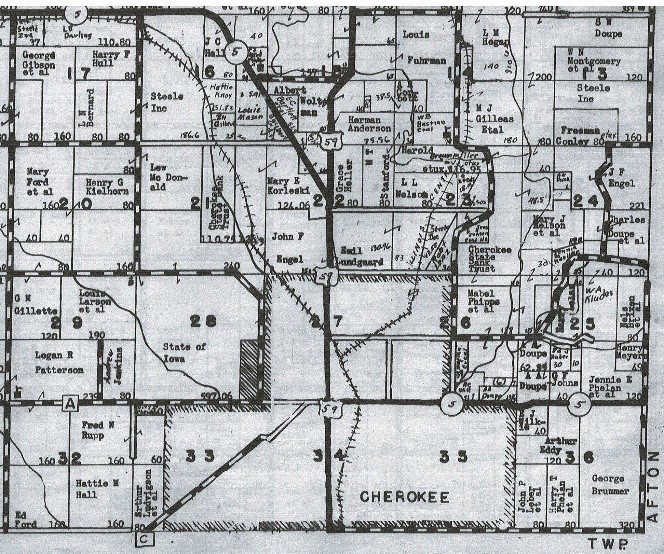 [Editor’s
note: In the above plat map for Cherokee Township in 1950, the Gillette
properties were 120 acres in Section 29 (with Guy’s name on the plat)
and 80 acres across the road in Section 20. The land in Section 28
marked ‘State of Iowa’ was the Mental Health Institute grounds and
farmland, the location of several of Dick’s stories. About ten minutes
by foot to the west of the Gillette farm is the Oak Hill Cemetery, the
final resting place for Dick’s parents, Dr. Prentiss Bowden Cleaves and
Jane Delaplane Cleaves. (Editors are grateful to John R. Snapp,
Cherokee Area Archives volunteer, for the plat map and the location of
the Gillette properties.)
|
|||||||||||||||||||||||||||||||||||
Return to Table of Contents Return to Families Index Return to Home Page